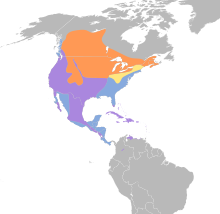American coot
| American coot | |
|---|---|
 |
|
| American coot in Edmonton, Alberta, June 2013 | |
| Scientific classification | |
| Kingdom: | Animalia |
| Phylum: | Chordata |
| Class: | Aves |
| Subclass: | Neornithes |
| Infraclass: | Neognathae |
| Superorder: | Neoaves |
| Order: | Gruiformes |
| Family: | Rallidae |
| Genus: | Fulica |
| Species: | F. americana |
| Binomial name | |
|
Fulica americana Gmelin, 1789 |
|
 |
|
| Breeding range Winter-only range Year-round range | |
| Synonyms | |
|
Fulica hesterna Howard, 1963 |
|
Fulica hesterna Howard, 1963
and see text
The American coot (Fulica americana), also known as a mud hen, is a bird of the family Rallidae. Though commonly mistaken to be ducks, American coots belong to a distinct order. Unlike the webbed feet of ducks, coots have broad, lobed scales on their lower legs and toes that fold back with each step in order to facilitate walking on dry land. Coots live near water, typically inhabiting wetlands and open water bodies in North America. Groups of coots are called covers or rafts. The oldest known coot lived to be 22 years old.
The American coot is a migratory bird that occupies most of North America. It lives in the Pacific and southwestern United States and Mexico year-round and occupies more northeastern regions during the summer breeding season. In the winter they can be found as far south as Panama. Coots generally build floating nests and lay 8–12 eggs per clutch. Females and males have similar appearances, but they can be distinguished during aggressive displays by the larger ruff (head plumage) on the male. American coots eat primarily algae and other aquatic plants but also animals (both vertebrates and invertebrates) when available.
The American coot is listed as “Least Concern” under the IUCN conservation ratings. Hunters generally avoid killing American coots because their meat is not as sought after as that of ducks.
Much research has been done on the breeding habits of American coots. Studies have found that mothers will preferentially feed offspring with the brightest plume feathers, a characteristic known as chick ornaments. American coots are also susceptible to conspecific brood parasitism and have evolved mechanisms to identify which offspring are theirs and which are from parasitic females.
The American coot was first described by Johann Friedrich Gmelin in 1789. A member of the family Rallidae, it has three subspecies: Fulica americana alai, F. a. caribaea, and F. a. ardesiaca. These subspecies, however, are sometimes considered to be their own separate species. Including these 'subspecies', there are 11 members of the genus Fulica distributed across the globe.
Coot fossils from the Middle of California have been described as Fulica hesterna but cannot be separated from the present-day American coot. However, the Pleistocene coot Fulica shufeldti (formerly F. minor), famously known as part of the Fossil Lake fauna, quite possibly was a paleosubspecies of the American coot (as Fulica americana shufeldti) as they only differed marginally in size and proportions from living birds. Thus, it seems that the modern-type American coots evolved during the mid-late , a few hundred thousand years ago.
...
Wikipedia

